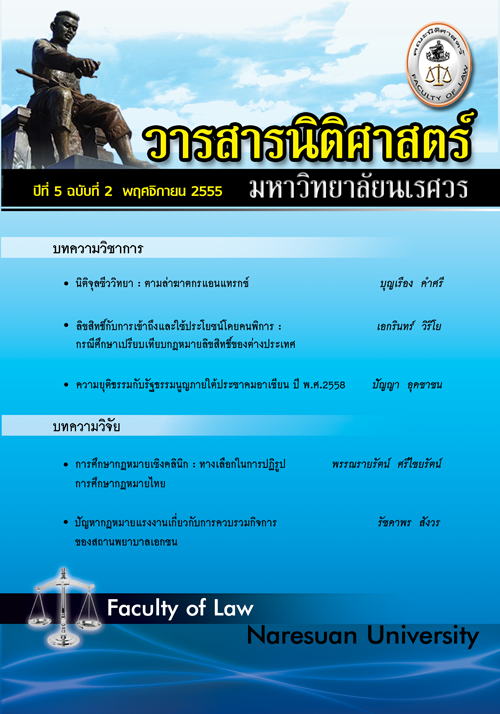Copyright and Access, Use by Persons with Disability : A Comparative Study of Copyright Legislations in Foreign Countries
Main Article Content
Abstract
Copyright is a significant legal mechanism for providing the protection of creative works. Prior to the use of the copyright-protected work by any other person, the authorization is needed from the copyright owner. Otherwise, it will be the copyright infringement on that work. However, in the copyright system, one mechanism is created to enable other persons to make use of that work without the need of authorization from the copyright owner, and is exempted from copyright infringement. This mechanism is known as “an exception to copyright infringement”. Moreover, at the present time, this exception has expanded to enable the use of copyright-protected work for the benefit of the persons with disability, the issue of which is a new topic for debate and has gained much attention on the international level. Therefore, it is worth studying
the copyright system on this issue, together with studying the copyright legislations in other countries on the comparative basis, in order to analyze the similarities and the differences on the copyright exception model for the benefit of the persons with disability.
Article Details
References
วัส ติงสมิตร. ลิขสิทธิ์: ตัวบทพร้อมข้อสังเกตเรียงมาตราและคำพิพากษา. กรุงเทพฯ: นิติธรรม, 2546.
Graeme B. Dinwoodie. “The Development and Incorporation of International Norms in the Formation of Copyright Law.” 62 Ohio State Law Journal, (2001).
Netanel, Neil W. “Why Has Copyright Expanded? Analysis and Critique.” New Directions in Copyright Law, Vol 6, Fiona Macmillan ed.,Edward Elgar. UCLA School of Law Research Paper No. 07-34 (2008).
WIPO. (November 3, 2003). Information Meeting on Digital Content for the Visually Impaired(DIGVI/IM/03). Geneva: Switzerland.
WIPO. (June 4, 2010). Timetable for the Adoption of a WIPO Treaty for an Improved Access for Blind,Visually-Impaired and Other Reading Disabled Persons, Standing Committee on Copyright and Related Rights, Twentieth Session (SCCR/20/9). Geneva: n.p.
WIPO. (March 16, 2011). Comparative List of Proposals Related to Copyright Limitations and Exceptions for the Visually Impaired Persons and Other Persons with Print Disabilities Standing Committee on Copyright and
Related Rights, Twenty-Second Session (SCCR/22/8). Geneva: n.p.
WIPO. (July 26, 2011). Report on the Work of the Standing Committee on Copyright and Related Rights, WIPO General Assembly, Fortieth (20th Ordinary Session) (WO/GA/40/6). Geneva: n.p.


